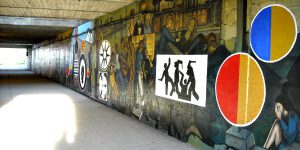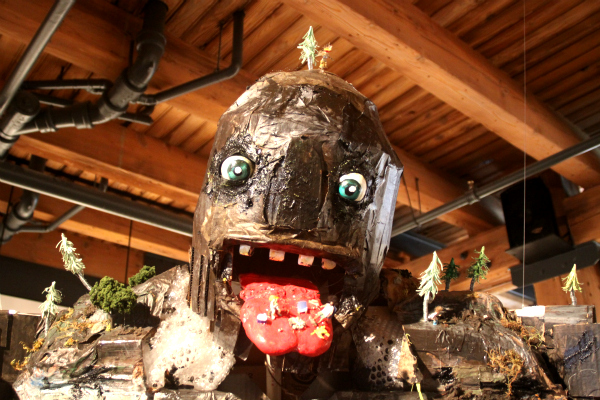
On Friday June 18th, Marwen, a non-profit youth art center in River North, held its opening exhibition for the Marwen Lab program. A three-year-old program, it is offered to Marwen students who wish to work on a single art project over the course of three 8-week terms. Open to Marwen’s most advanced high schoolers, students must apply and be accepted into the program. Speaking with each of the students, I was reminded of the unique power of high school art: it expresses what it’s like to be a teenager. Though the pieces in the show were inspired by a wide variety of themes, certain students honed in on the high school experience. The charged, powerful emotions of adolescence were the focus of Afiya Hudgins’ works. Meanwhile, Henry Novak was inspired by the anxiety related to making that first big move from home to college.
Overall, the pieces were breathtaking and sophisticated. The Marwen Lab instructors were amazed, as well, “I’ve never been so proud and so impressed by a student exhibition. And they were clearly blown away too,” said Lab instructor Christian Ortiz. “I don’t think any of them had realized the amount of work that everyone had put into their art. But for me, walking through the exhibition, I was so in awe by the caliber of the work and so astonished at how far they’ve gotten through the course of this program. They really were such a dedicated group of students with strong ideas and astounding visions.”
Katie Rodrigues, an instructor and manager of the program was in a similar state of awe. “Seeing the exhibition installed, I was so impressed with the quality of the work and the distinct style and individuality of each student’s project. During our last class, we had time to reflect with the students and I was brought to tears by many of their comments. It was a very gratifying year.”
To understand better how all their impressive work came to be, I spoke with four of the Lab students at the opening. Below are their artist statements followed by explanations of their lab experiences.
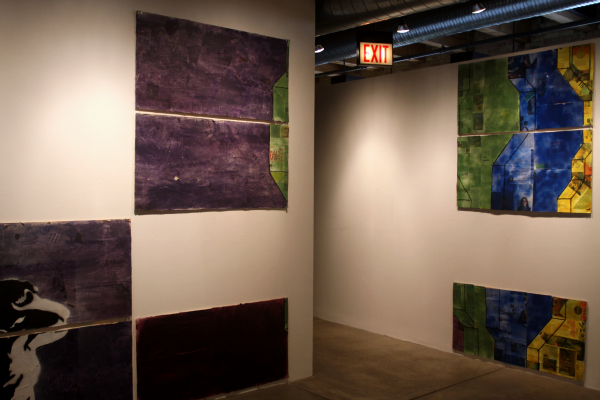
Henry Novak: Artist Statement
There is no doubt that the college application process is anxiety inducing. I have often felt overwhelmed by the amount of information presented to me and the uncertainty of the future. Where was I going? What was I being shown? How would my life change?
Like most students I toured my potential schools to help relieve some of my anxieties. When visiting colleges, I only perceived basic information about the environment, such as shape and color. The overwhelming nature of balancing my college decision with fears of moving away is the inspiration for my piece.
Zachary Johnson (ZJ): What was the original spark or inspiration behind your pieces?
HN: Well it started off as the idea of being trapped…but halfway through I realized I didn’t really connect with that idea anymore so I changed it to the fears of going away. With me going off to college there’s a lot that is changing in my life. So, I was inspired by going away, being overwhelmed by information and just not knowing what’s going to happen next.
ZJ: What did you enjoy most about Lab?
HN: I really enjoyed the time. I’ve never worked on a project for such an extended period of time. And I got really close with the people in my group because of that. It was like really working in an artist community setting. It felt like being an actual artist.
ZJ: What did you find to be most challenging about the program?
HN: Time management. I’m usually pretty good with it, but I’ve never spent so much time on a project. Three terms sounds really long and then you get to the end and there’s all this stuff you realize you still have to do.
ZJ: What did you find to be most challenging about the creation of your pieces?
HN: Mostly it was making sure that I got my ideas across. I’d never really worked with making an actual, really meaningful piece of artwork. I just had to keep making sure that I was focusing on my message. That’s really where the artist community came into play; I could ask my friends if something made sense or if they could see where I was going with it.
ZJ: What do you feel you learned about yourself through the program?
HN: I think I learned a lot about myself as an artist and as a person in general because I would come in and work on [my pieces] once or twice a week. It really changed from week-to-week based on what happened to me that last week. It was just interesting to see how much you could be affected by something and how that reflects into your art.
ZJ: You’ve just graduated high school as well as Marwen. Where are you heading in the fall?
HN: To the Massachusetts College of Art in Boston. I’m planning on going into art education.
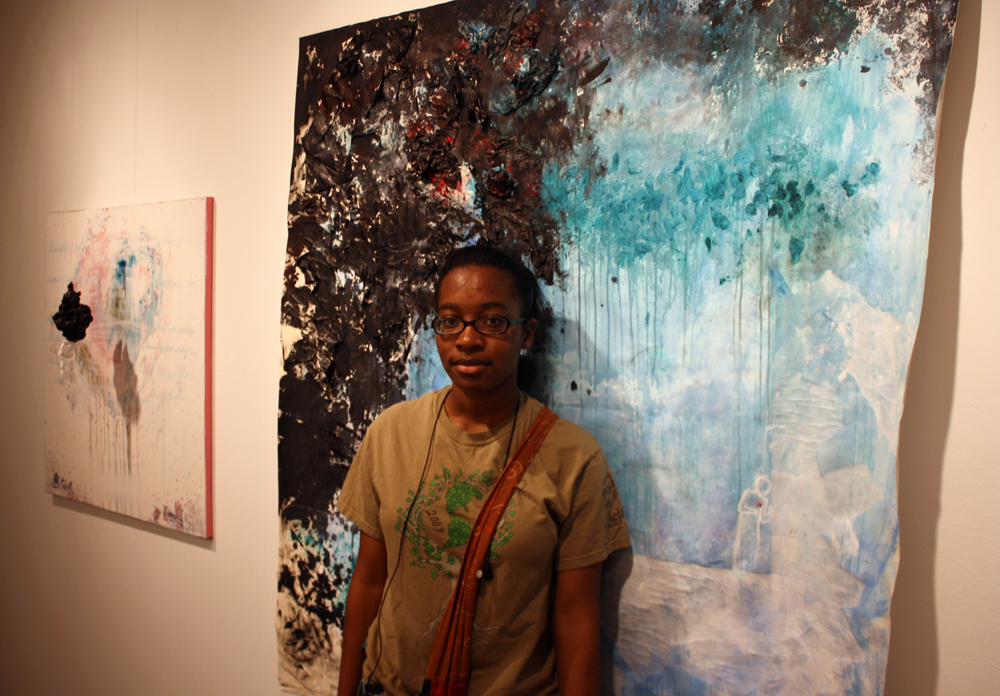
Afiya Hudgins: Artist Statement
Since about Junior year I’ve been digging my own personal hole. It’s a hole in the sky – the highest place I could be but not where I should be.
It’s a place of joy but not fulfillment. Like how an alcoholic enjoys drinking but gains no merit from it, or how your favorite dessert may be delicious but only fills you with the guilt of high consumption.
Everyone exists in their own little void. From my own void I can see those around me, and those below me. The holes we dig can be hope-filled and shallow or depressingly deep. And these holes only fill themselves with troubles and emotions to the point that they are no longer our comfortable little niches but dark heavy masses. Blobs. Dark shifty globs that we live with. And the deeper you’re personal niche is the larger this mass of darkness can be. On the ground, or in the sky, these blobby masses drag and pull, sometimes picking up the people around them. In the sky they hang you, on the ground they bring you to your knees and crush you.
There is no real single personification for these masses, they are individualistic, and sometimes undistinguishable. Unidentified.
My pieces are meant so that others may identify something of them in themselves. Emotions are varied; color, shape, and texture are meant to compel these emotions. Black being one of the most important colors. It is the natural color of everything around us. When all color spectrums of light come together they make white but, ironically, when color spectrums of the earth come together they create black.
In the end, I want the work to inspire us all to find the light and power within to dig ourselves out.
ZJ: What was the original spark or inspiration behind your pieces?
AH: What inspired me was talking with friends and hearing out their issues and my own issues with school and things like that. I realized that everyone’s high on emotions and there’s so many things that are going on in people’s lives. I felt like I wanted to do something that was based on that.
ZJ: What did you find to be most challenging about the creation of your pieces?
AH: A big challenge was taking what was in my head and making it physical. What I had the most difficulty with were the 3D elements of my work. The ceiling foam that I used wasn’t really cooperating with me, so I really struggled with it a lot. It doesn’t look like it, but it was actually pretty hard to work with.
ZJ: What did you find to be most challenging about the Marwen Lab program?
AH: Getting down here was the biggest challenge. I’m all the way at the other side of the city. My school is on 111th and Pulaski, and I had to take a bus and then take the red line for an hour. But I ended up getting down here on time
ZJ: What did you enjoy most about Lab?
AH: I enjoyed everything. We didn’t just stay in the classrooms all day we actually went out and talked to other artists. We talked to our fellow artists and it was inspirational to see everyone else’s work building around you. And it kind of inspired you to finish yours. Nobody wanted anybody to be incomplete. You’d think, “Oh no. This person’s not finished.” And you’d cheer them on…it was just great being surrounded by other artists with a common goal set. It was the collaborative effort that I enjoyed the most, even though we were all in our own little worlds with our projects.
ZJ: What do you feel you learned about yourself through the program?
AH: I fully acknowledged and recognized my issues and realized that it’s all about me taking control over them now. Working on these pieces has taken a full year so now I’m thinking, “Ok, I’m painting on these issues and relationships to emotions and what not. Now, what am I going to do about it? What’s the next step?” You can do one thing, but it doesn’t mean it’s going to get you anywhere. So, it’s the process that initiated it, that thinking.
ZJ: You’ve just graduated high school as well as Marwen. Where are you heading in the fall?
AH: The Boot [Marwen’s graduation party, occurring alongside the Lab opening] is basically kicking me out. I’m going to go to college but I’m going to be doing Gallery 37 for the summer and then I’ve applied for this year-up program. I’ll be doing that for a year. It gives me college credits once I’m done with it. Then I’ll move on to college. I wanted something different than schooling right away.
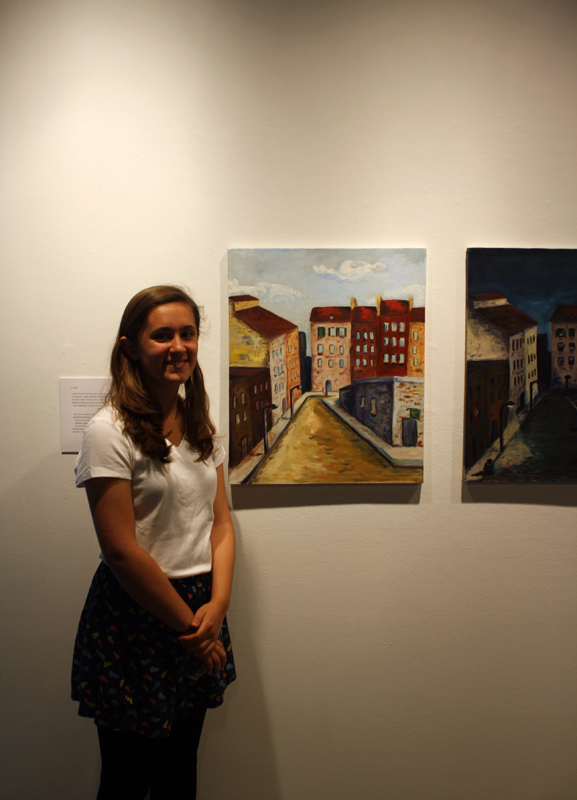
Erin Miller: Artist Statement
I opened “The Diary of Anne Frank” when I was ten and nothing has been so intriguingly terrifying since. I couldn’t understand the fear they must have felt notknowing what was going to happen—that they sat in an attic for months at a time just waiting, not for anything in particular, just waiting; that they stood staunchly facing the unknown with a hope of defeating it—a task that many of us would find quite impossible or utterly terrifying.
Last summer, I traveled to Europe to visit concentration camps and the cities most impacted by the Holocaust. I heard so many personal stories, visited so many historic locations, and invested so much time in to trying to understand the Holocaust. Ultimately, though, I realized that I couldn’t. I never will. The Holocaust was an experience that few now alive will ever really understand. The little that we can understand deserves all our appreciation. We can acknowledge their stories of bravery, compassion, and endurance. We can acknowledge how they made it through the terror of the unknown.
We can acknowledge that their story isn’t over yet.
ZJ: What was the original spark or inspiration behind your pieces?
EM: I read the Diary of Ann Frank when I was in fifth grade and I kind of just became obsessed with the Holocaust. I’ve been interested in it ever since. Then I went on a trip to Europe last year with my school specifically to learn about it. So, we visited Auschwitz and the Warsaw ghetto, those cities. For whatever reason it’s just always been an event that’s really close to my heart, so I decided to create my Marwen lab pieces about it.
ZJ: What did you find to be most challenging about the creation of your pieces?
EM: I think the most difficult thing was trying to really narrow in on exactly what I wanted to say. I have so many ideas and feelings about the Holocaust and things I just want to paint instead of what I should be painting and saying with my pieces. I really had to put a message into my paintings for the first time, so it was a good challenge. But it was definitely a challenge.
ZJ: What did you enjoy most about Lab?
EM: I loved being able to work on one thing for the entire year and really put my own ideas behind something. But the thing I really wasn’t expecting was that I felt like a family with my class after the entire year. On the last day we held a little meeting, and we just formed a great little family of Marwen Lab students.
ZJ: What do you feel you learned about yourself through the program?
EM: That patience is definitely a virtue and it takes a long time to work on things. You really have to spend time thinking about what you want to say and what you believe. It’s just so easy to go on living life instead of really thinking about what you’re doing and being deliberate with what you’re saying. Like, with the Holocaust idea, it’s so easy for us to just forget how much of a traumatic experience it was. So for me to reflect on that every week and think about how precious so many lives were — I guess it wasn’t anything huge, but just a slow maturity in terms of how I think about my life and terms of how I think about my artwork.
ZJ: Were there any particular moments that stood out to you during Lab?
EM: There was one peer critique that we had where we mixed up students and teachers. I came home and I was just so excited and inspired. It was so exciting for me to hear all these ideas that people my age were having about artwork — Things that we wanted to be saying and ideas that we had. It was SO exciting for me to see that. Ever since that night I’ve just been ten times more excited to make art because other people are so excited about it too. That just makes me really happy.

Queion Swift: Artist Statement
The significance of any moment lies in the simple fact that it happened. As an artist, my job is to convey the same emotional depth and feeling to my audience as I felt when taking the photograph. When viewing my work, one is literally looking through my eyes at a moment in my life and the people who I share it with. For that reason the medium of Polaroid is special because the end-product is an immediate representation of the moment I have captured. In my work it is important for me to convey this concept; all moments are significant because you lived them and beauty can come from anywhere.
ZJ: What was the original spark or inspiration behind your pieces
QS: One day last summer I was at Urban Outfitters. There was this book called The Polaroid Book and people had taken all kinds of pictures…It was really interesting, so I thought, why can’t I do that? And so I looked it up and Polaroid was really hard to get your hands on because they stopped making the film. And the only way to do it was if you could do 667 or 669, the peel-apart. So, I proposed it for Marwen Lab and Katie [Rodrigues, Lab instructor] found a way for me to be able to do it. So, that was my initial work with it.
ZJ: What did you find to be most challenging about the creation of your pieces?
QS: The hardest part about my piece was trying to make sure that I stayed with the same concept. It was really easy to get off track, lost with the Polaroid aspect of it. And so the hardest part was trying to maintain that meaning that I originally set off with.
ZJ: What did you find to be most challenging about the Marwen Lab program?
The hardest part of Lab, I guess was kind of the same. Staying on track. Katie would make us set deadlines, like, what do you want to have done on this day. If you didn’t have it, it wasn’t a problem, but at the same time you had to work that much harder to make sure you were producing work that could be shown at the end of the year.
ZJ: What did you enjoy most about Lab?
QS: That it really showed me that critique wasn’t a bad thing. Because I’m not a kind of person that deals with criticism of any kind well. So, working with the same people over the span of weeks and building that relationship, you know that they’re not telling you anything to demean you and your work, they’re trying to help you and encourage you. And so that was a real benefit to me as an artist.
ZJ: What do you feel you learned about yourself through the program?
QS: I learned that once I set my mind to something nothing but death can keep me from it.
The Marwen Lab exhibition has come down in preparation for Marwen’s spring term exhibition. The opening is on Friday, July 15th from 5 to 7pm.
